|
|
|
Sort Order |
|
|
|
Items / Page
|
|
|
|
|
|
|
| Srl | Item |
| 1 |
ID:
162327
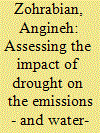

|
|
|
|
|
| Summary/Abstract |
This study investigates how technological transitions across California's power sector have shifted its state-level carbon dioxide emissions and cooling water consumption intensities. Its ultimate goal is to evaluate how the state's climate mitigation and environmental policies have affected the power sector's vulnerability to extreme drought and how extreme drought has affected progress towards the state's climate mitigation priorities. The study analyzes the period spanning 2010–2016, which includes one of the state's most severe droughts on record. The results indicate that the growth of variable renewable energy generation has helped offset some of the negative consequences of drought, which include increased emissions and cooling water usage by natural gas generators during periods of low hydropower. However, the retirement of the San Onofre nuclear power plant has delayed the overall decarbonization of the state's power sector, and the closure of significant coastal power plant capacity could increase the freshwater consumption of the power sector if replacement capacity is not cooled with alternative cooling water sources or dry cooling systems. The noted tradeoffs between greenhouse gas mitigation priorities, freshwater dependency, and vulnerability to climatic events highlight the importance of holistic decision making as regional power grids transition to cleaner generation sources.
|
|
|
|
|
|
|
|
|
|
|
|
|
|
|
|
| 2 |
ID:
191306


|
|
|
|
|
| Summary/Abstract |
Climate change received substantial attention because of its implications on all spheres of life. This study examined the effects of climate change mitigation on the economic, environmental, and social development of 18 European countries based on the environmental performance index for data from 1981 to 2018; control variables include foreign direct investment, trade openness, renewable and non-renewable energy, population growth and life expectancy. Panel quantile regression result shows that climate change mitigation is ineffective in promoting economic growth in an aggregate manner; only high and moderate environmental performance ranking countries manage to spur economic growth and social development. Low environmental performance rankings countries reveal no impact of climate change mitigation. Climate change mitigation promotes environmental development for all countries. Trade openness and energy choices are crucial to ensure climate change mitigation efforts. Findings indicate that the European Union needs well-designed strict policies that emphasize and help countries increase the share of renewable energy compared to fossil fuels and promote the integration of climate mitigation technology at the national and regional level through lenient tariffs, subsidization, financial aid, and technical assistance that help low economic growth countries accelerate the transition that is required to achieve overall economic, social, and environmental goals.
|
|
|
|
|
|
|
|
|
|
|
|
|
|
|
|
| 3 |
ID:
128370


|
|
|
|
|
| Publication |
2014.
|
| Summary/Abstract |
International shipping transports around 90% of global commerce and is of major importance for the global economy. Whilst it is the most efficient and environmentally friendly mode of transport, CO2 emissions from shipping activities still account for an estimated 3% of global emissions. One means of significantly reducing fuel consumption and thereby GHG emissions from shipping are wind propulsion technologies (i.e. towing kites, Flettner rotors and sails) - yet current market uptake is very low. Therefore, the aim of this article is to identify the barriers and drivers for the uptake of wind propulsion technologies. To this end, the theoretical approach of technological innovation systems is adopted. This approach combines structural system components with so-called system functions which represent the dynamics underlying structural changes in the system. The fulfillment of these functions is considered important for the development and diffusion of innovations. Based on newspaper and academic articles, online expert interviews and semi-structured interviews, the level of function fulfillment is evaluated, followed by the identification of structural drivers and barriers influencing function fulfillment. Third, the possibilities to influence these drivers and barriers are discussed.
|
|
|
|
|
|
|
|
|
|
|
|
|
|
|
|
| 4 |
ID:
115634


|
|
|
|
|
| Publication |
2012.
|
| Summary/Abstract |
Even though energy poverty alleviation and climate change mitigation are inextricably linked policy goals, they have remained as relatively disconnected fields of research inquiry and policy development. Acknowledging this gap, this paper explores the mainstream academic and policy literatures to provide a taxonomy of interactions and identify synergies and trade-offs between them. The most important trade-off identified is the potential increase in energy poverty levels as a result of strong climate change action if the internalisation of the external costs of carbon emissions is not offset by efficiency gains. The most significant synergy was found in deep energy efficiency in buildings. The paper argues that neither of the two problems - deep reductions in GHG emissions by mid-century, and energy poverty eradication - is likely to be solved fully on their own merit, while joining the two policy goals may provide a very solid case for deep efficiency improvements. Thus, the paper calls for a strong integration of these two policy goals (plus other key related benefits like energy security or employment), in order to provide sufficient policy motivation to mobilise a wide-scale implementation of deep energy efficiency standards.
|
|
|
|
|
|
|
|
|
|
|
|
|
|
|
|
| 5 |
ID:
101404


|
|
|
|
|
| Publication |
2011.
|
| Summary/Abstract |
Many policy-makers view nuclear power as a mitigation for climate change. Efforts to mitigate and adapt to climate change, however, interact with existing and new nuclear power plants, and these installations must contend with dilemmas between adaptation and mitigation. This paper develops five criteria to assess the adaptation-mitigation dilemma on two major points: (1) the ability of nuclear power to adapt to climate change and (2) the potential for nuclear power operation to hinder climate change adaptation. Sea level rise models for nine coastal sites in the United States, a review of US Nuclear Regulatory Commission documents, and reports from France's nuclear regulatory agency provided insights into issues that have arisen from sea level rise, shoreline erosion, coastal storms, floods, and heat waves. Applying the criteria to inland and coastal nuclear power plants reveals several weaknesses. Safety stands out as the primary concern at coastal locations, while inland locations encounter greater problems with interrupted operation. Adapting nuclear power to climate change entails either increased expenses for construction and operation or incurs significant costs to the environment and public health and welfare. Mere absence of greenhouse gas emissions is not sufficient to assess nuclear power as a mitigation for climate change.
|
|
|
|
|
|
|
|
|
|
|
|
|
|
|
|
| 6 |
ID:
121318


|
|
|
|
|
| Publication |
2013.
|
| Summary/Abstract |
In the frame of the European project titled "Zero Waste" (1G-MED08-533), a tool has been developed called CO2ZW for estimating the GHG emissions for the management of MSW at the municipal, regional or national levels with small amounts of input data. The objective of this paper is to demonstrate that the CO2ZW tool allows us to inventory and monitor GHG emissions from MSW following the IPCC guidelines for national inventories and the principles of life cycle assessment (LCA). The CO2ZW tool includes the key stages and parameters for calculating GHG emissions and includes several advantages regarding the implementation of the default values of the Mediterranean European countries, an improvement in accessibility (online free access) and two approaches for calculating GHG emissions from landfills. The results of this paper show that for countries with medium and high rates of deposition, implementation of the European policies limiting waste in landfills can contribute to mitigate climate change in a remarkable way. With the CO2ZW tool, it is possible to evaluate waste management choices depending on waste management infrastructures and waste policies, along with the quantification of GHG emissions from MSW management, which is essential to guide waste policy options and climate change solutions.
|
|
|
|
|
|
|
|
|
|
|
|
|
|
|
|
| 7 |
ID:
109388


|
|
|
|
|
| Publication |
2011.
|
| Summary/Abstract |
Costs and benefits of building energy efficiency are estimated as a means of reducing greenhouse gas emissions in Pittsburgh, PA and Austin, TX. The analysis includes electricity and natural gas consumption, covering 75% of building energy consumption in Pittsburgh and 85% in Austin. Two policy objectives were evaluated: maximize GHG reductions given initial budget constraints or maximize social savings given target GHG reductions. This approach evaluates the trade-offs between three primary and often conflicting program design parameters: initial capital constraints, social savings, and GHG reductions. Results suggest uncertainty in local stocks, demands, and efficiency significantly impacts anticipated outcomes. Annual GHG reductions of 1 ton CO2 eq/capita/yr in Pittsburgh could cost near nothing or over $20 per capita annually. Capital-constrained policies generate slightly less social savings (a present value of a few hundred dollars per capita) than policies that maximize social savings. However, sectors and end uses targeted for intervention vary depending on policy objectives and constraints. Optimal efficiency investment strategies for some end uses vary significantly (in excess of 100%) between Pittsburgh and Austin, suggesting that resources and guidance conducted at the national scale may mislead state and local decision-makers. Results are used to provide recommendations for efficiency program administrators.
|
|
|
|
|
|
|
|
|
|
|
|
|
|
|
|
| 8 |
ID:
094857


|
|
|
|
|
| Publication |
2010.
|
| Summary/Abstract |
The post-2012 climate policy framework needs a global commitment to deep greenhouse gas emission cuts. This paper analyzes reaching ambitious emission targets up to 2050, either -10% or -50% from 1990 levels, and how the economic burden from mitigation efforts could be equitably shared between countries. The scenarios indicate a large low-cost mitigation potential in electricity and industry, while reaching low emission levels in international transportation and agricultural emissions might prove difficult. The two effort sharing approaches, Triptych and Multistage, were compared in terms of equitability and coherence. Both approaches produced an equitable cost distribution between countries, with least developed countries having negative or low costs and more developed countries having higher costs. There is, however, no definitive solution on how the costs should be balanced equitably between countries. Triptych seems to be yet more coherent than other approaches, as it can better accommodate national circumstances. Last, challenges and possible hindrances to effective mitigation and equitable effort sharing are presented. The findings underline the significance of assumptions behind effort sharing on mitigation potentials and current emissions, the challenge of sharing the effort with uncertain future allowance prices and how inefficient markets might undermine the efficiency of a cap-and-trade system.
|
|
|
|
|
|
|
|
|
|
|
|
|
|
|
|
| 9 |
ID:
185395
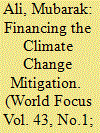

|
|
|
|
|
| Summary/Abstract |
With the advancement of the 21st Century, the energy requirement has increased manifold. The consumption of energy has been on the rise at
both levels i.e., individuals as well as small, medium and heavy industries.
|
|
|
|
|
|
|
|
|
|
|
|
|
|
|
|
| 10 |
ID:
149990
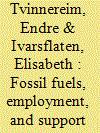

|
|
|
|
|
| Summary/Abstract |
We know that the costs of implementing various climate change mitigation policies are not uniformly distributed across individuals in society, but we do not know to what extent this unequal cost distribution influences public support for these various policies. This study shows that cost distribution is an important explanation for variations in public support for various climate policies. Using individual-level data on industry of employment and support for a range of climate policies, we find that those employed in the fossil fuel industry are less likely to support climate policies that are particularly costly to their industry, but are as likely as everybody else to support policies with lower costs to the industry. This finding challenges the traditional bifurcation between climate change "skeptics" and "acceptors." Furthermore, we find that opposition to renewable energy by large fossil fuel producers and consumers, identified in the political economy literature, is not uniformly found among these companies’ employees. The most important implication of this study for policy makers is that support for climate policies is sensitive to the compensation of exposed groups and stimulation of alternative avenues for employment.
|
|
|
|
|
|
|
|
|
|
|
|
|
|
|
|
| 11 |
ID:
149991


|
|
|
|
|
| Summary/Abstract |
We know that the costs of implementing various climate change mitigation policies are not uniformly distributed across individuals in society, but we do not know to what extent this unequal cost distribution influences public support for these various policies. This study shows that cost distribution is an important explanation for variations in public support for various climate policies. Using individual-level data on industry of employment and support for a range of climate policies, we find that those employed in the fossil fuel industry are less likely to support climate policies that are particularly costly to their industry, but are as likely as everybody else to support policies with lower costs to the industry. This finding challenges the traditional bifurcation between climate change "skeptics" and "acceptors." Furthermore, we find that opposition to renewable energy by large fossil fuel producers and consumers, identified in the political economy literature, is not uniformly found among these companies’ employees. The most important implication of this study for policy makers is that support for climate policies is sensitive to the compensation of exposed groups and stimulation of alternative avenues for employment.
|
|
|
|
|
|
|
|
|
|
|
|
|
|
|
|
| 12 |
ID:
166341
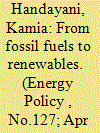

|
|
|
|
|
| Summary/Abstract |
This study analyses a diffusion of renewable energy in an electricity system accounting for technological learning. We explore long-term scenarios for capacity expansion of the Java-Bali electricity system in Indonesia, considering the country’s renewable energy targets. We apply the Long-range Energy Alternative Planning (LEAP) model with an integration of technological learning. Our results reveal that, at the medium and high pace of technological learning, the total costs of electricity production to achieve the long-term renewable energy target are 4–10% lower than the scenario without considering technological learning. With respect to technology, solar PV and wind become competitive with other types of renewables and nuclear. Moreover, the fulfilment of the renewable energy targets decreases CO2 emissions by 25% compared to the reference scenario. Implications of our results indicate that energy policies should focus on the early deployment of renewables, upgrading the grid capacity to accommodate variable renewable energy, and enabling faster local learning.
|
|
|
|
|
|
|
|
|
|
|
|
|
|
|
|
| 13 |
ID:
115180
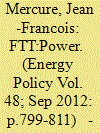

|
|
|
|
|
| Publication |
2012.
|
| Summary/Abstract |
This work introduces a model of Future Technology Transformations for the power sector (FTT:Power), a representation of global power systems based on market competition, induced technological change (ITC) and natural resource use and depletion. It is the first component of a family of sectoral bottom-up models of technology, designed for integration into the global macroeconometric model E3MG. ITC occurs as a result of technological learning produced by cumulative investment and leads to highly nonlinear, irreversible and path dependent technological transitions. The model uses a dynamic coupled set of logistic differential equations. As opposed to traditional bottom-up energy models based on systems optimisation, such differential equations offer an appropriate treatment of the times and structure of change involved in sectoral technology transformations, as well as a much reduced computational load. Resource use and depletion are represented by local cost-supply curves, which give rise to different regional energy landscapes. The model is explored for a single global region using two simple scenarios, a baseline and a mitigation case where the price of carbon is gradually increased. While a constant price of carbon leads to a stagnant system, mitigation produces successive technology transitions leading towards the gradual decarbonisation of the global power sector.
|
|
|
|
|
|
|
|
|
|
|
|
|
|
|
|
| 14 |
ID:
177368
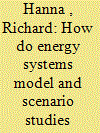

|
|
|
|
|
| Summary/Abstract |
Scenarios may be qualitative or quantitative, the latter of which can be developed using energy systems models. This study explores how different energy systems models and scenarios explicitly represent and assess potential disruptions and discontinuities. The focus is on futures studies and forward-looking scenario and modelling exercises. We apply definitions of ‘emergent’ (uncoordinated) and ‘purposive’ (coordinated) disruption to a systematic review on how energy systems models and scenarios have been used to capture disruption and discontinuity. We first conducted a review of reviews of energy models and scenarios to provide an overview of their common classifications. Additional searches then sought studies which use different types of models and scenarios to explore disruption and discontinuity. We analyse a subset of 30 of these modelling or scenario studies in which authors self-identify and represent disruption or discontinuity, finding that the most frequently used methods were qualitative, exploratory foresight scenarios or agent-based models. We conclude that policy makers could prepare more effectively for social, economic and political disruption by integrating multidisciplinary insights from social and political sciences, engineering and economics through a broader range of methods: exploratory, foresight scenarios, simulation and agent-based models and repurposed energy systems optimisation models.
|
|
|
|
|
|
|
|
|
|
|
|
|
|
|
|
| 15 |
ID:
150665


|
|
|
|
|
| Summary/Abstract |
A fundamental policy design choice in government-led climate change mitigation is: what role should flexibility mechanisms like carbon offsetting play in reducing greenhouse gas (GHG) emissions. Since public opinion affects the policy choices of government, we investigate how arguments regarding carbon offsetting's economic efficiency, effectiveness, and ethicality, which have been key points in the public debate, impact the public's preferences. We fielded an online framing experiment in the United States (N=995) to empirically identify how arguments for and against carbon offsetting influence public preferences for the inclusion of offsetting in national GHG mitigation policy. We find that the public's support for international offsetting increases and support for reductions at their source (i.e. within firms' own operations) diminishes when considerations of economic efficiency gains are at the forefront. Support for offsetting declines when individuals are confronted with arguments concerning its effectiveness and ethicality, which suggests that future policies will require clear standards of additionality in order to address these concerns. Moreover, we find that how carbon offsetting is framed matters even amongst climate skeptics and support could potentially be enhanced via improved communication on efficiency gains.
|
|
|
|
|
|
|
|
|
|
|
|
|
|
|
|
| 16 |
ID:
176830
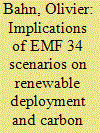

|
|
|
|
|
| Summary/Abstract |
This paper proposes a detailed analysis of the evolution of Canadian energy systems under some selected EMF (Energy Modeling Forum) 34 scenarios. Our analysis is based on NATEM, an energy model that follows the TIMES approach of the International Energy Agency to represent in detail the energy sector of each of the 13 Canadian provinces and territories. NATEM shows that imposing different renewable penetration constraints for electricity generation has limited impacts outside the electricity sector. In particular, greenhouse gas (GHG) emissions continue to increase over time. Conversely, the imposition of a carbon tax has broader impacts on Canadian energy systems and on GHG emissions that are almost stabilized. However, the level of the carbon tax envisions by the EMF 34 study (increasing to a maximum level of $130 per tonne by 2050) is not high enough, in a Canadian context, to trigger a decrease of GHG emissions over time as mandated by Canadian climate policies.
|
|
|
|
|
|
|
|
|
|
|
|
|
|
|
|
| 17 |
ID:
167002
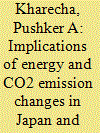

|
|
|
|
|
| Summary/Abstract |
Following the March 2011 nuclear power plant accident in Fukushima, Japan, nuclear power production declined sharply in that country as well as Germany. Despite widespread media coverage of CO2 emission increases in the first few years afterward, subsequent energy and emission changes and their implications are not well-studied. Here we analyze energy, electricity, and CO2 emissions data for both countries through 2017. We also quantify the human health and CO2 implications of two simple yet illuminating scenarios: What if both countries had reduced fossil fuel power output instead of nuclear? And what if the US and the rest of Europe eliminate their remaining nuclear power? We find that emissions increased after Fukushima until 2013 but decreased thereafter due to record-high renewable energy production and lower total energy use. However our “what if” scenarios demonstrate that these two countries could have prevented 28,000 air pollution-induced deaths and 2400 MtCO2 emissions between 2011 and 2017. Germany can still prevent 16,000 deaths and 1100 MtCO2 emissions by 2035 by reducing coal instead of eliminating nuclear as planned. If the US and the rest of Europe follow Germany's example they could lose the chance to prevent over 200,000 deaths and 14,000 MtCO2 emissions by 2035.
|
|
|
|
|
|
|
|
|
|
|
|
|
|
|
|
| 18 |
ID:
186237


|
|
|
|
|
| Summary/Abstract |
In India, solar and wind have emerged as key components of the country’s strategy for a clean energy future. Although hydropower has historically been the main source of clean and renewable energy in the country, it currently lags solar and wind in terms of deployment. Nonetheless, hydropower has a critical role in hastening India’s clean energy transition and climate change mitigation efforts. Hydropower’s ability to integrate large shares of variable and intermittent renewable energy sources, such as solar and wind, in the country’s electricity system is increasingly important as their penetrations increase. Hydropower installations also provide crucial services like water supply, irrigation, flood protection, and drought mitigation, navigation, tourism, and recreation. Beyond ths, it also serves strategic purposes. By alleviating the socio-economic conditions of border villages and communities in the India-Tibetan border regions such as Arunachal Pradesh, hydropower projects can help India consolidate its administration in the remote border regions, and strengthen its security and defence preparedness. However, such projects are inherently challenging and can have adverse environmental and social impacts. But these can be mitigated by adopting new social and environmental safeguards and more robust and cost-effective technological solutions.
|
|
|
|
|
|
|
|
|
|
|
|
|
|
|
|
| 19 |
ID:
132657
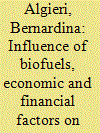

|
|
|
|
|
| Publication |
2014.
|
| Summary/Abstract |
Biofuels production has experienced rapid growth worldwide as one of the several strategies to promote green energy economies. Indeed, climate change mitigation and energy security have been frequent rationales behind biofuel policies, but biofuels production could generate negative impacts, such as additional demand for feedstocks, and therefore for land on which to grow them, with a consequent increase in food commodity prices. In this context, this paper examines the effect of biofuels and other economic and financial factors on daily returns of a group of commodity futures prices using Generalized Autoregressive Conditional Heteroskedasticity (GARCH) family models in univariate and multivariate settings. The results show that a complex of drivers are relevant in explaining commodity futures returns; more precisely, the Standard and Poor×s (S&P) 500 positively affects commodity markets, while the US/Euro exchange rate brings about a decline in commodity returns. It turns out, in addition, that energy market returns are significant in explaining commodity returns on a daily basis, while monetary liquidity is not. This would imply that biofuel policy should be carefully monitored in order to avoid excessive first-generation subsidization, which would trigger a fuel vs. food conflict.
|
|
|
|
|
|
|
|
|
|
|
|
|
|
|
|
| 20 |
ID:
150777


|
|
|
|
|
| Summary/Abstract |
Decision making in Iran's energy and environment-related issues has always been tied to complexities. Discussing these complexities and the necessity to deal with them, this paper strives to help the country with a tool by introducing Richest Alternatives for Implementation to Supply Energy (RAISE), a mixed integer linear programming model developed by the means of GNUMathprog mathematical programming language. The paper fully elaborates authors' desired modeling mentality and formulations on which RAISE is programmed to work and verifies its structure by running a widely known sample case named “UTOPIA” and comparing the results with other works including OSeMOSYS and Temoa. The model applies RAISE model to Iranian energy sector to elicit optimal policy without and with a CO2 emission cap. The results suggest promotion of energy efficiency through investment on combined cycle power plants as the key to optimal policy in power generation sector. Regarding oil refining sector, investment on condensate refineries and advanced refineries equipped with Residual Fluid Catalytic Cracking (RFCC) units are suggested. Results also undermine the prevailing supposition that climate change mitigation deteriorates economic efficiency of energy system and suggest that there is a strong synergy between them. In the case of imposing a CO2 cap that aims at maintaining CO2 emissions from electricity production activities at 2012 levels, a shift to renewable energies occurs.
|
|
|
|
|
|
|
|
|
|
|
|
|
|
|
|
|
|
|
|
|